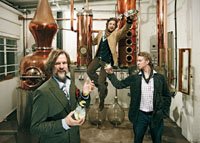
Steam-based system specified for artisanal gin distillery
The Project
Established in Hammersmith in 2009, Sipsmith Distillery uses the first copper still to launch in London for close to 200 years, crafting uncomprimising, artisanal gins and vodkas.
Established in 2009, Sipsmith Distillery crafts artisanal gins and vodkas.
The distillery gives female names to each of its stills and the first, Prudence, orginally used electricity to power elements in the steam jacket surrounding it.
As Sipsmith’s export market grew, production increased, and the founders realised that additional stills were required to meet demand. After Constance, the distiller’s third and larger still, Sipsmith decided to switch from an electrically-heated process to one using a steam boiler.
Fulton Sales and Marketing Manager Doug Howarth says: We visited Sipsmith Distillery when they were using German electrically-powered stills but wanted to install a gas-fired steam boiler for their new, larger premises.
Our area manager discussed the specifications and options with them and an order was subsequently placed for a Fulton 20J vertical boiler and associated ancillaries. We continued to provide assistance and technical support throughout the installation and during commissioning.
Sipsmith Distillery uses the first copper still to launch in London for close to 200 years.
Steam-based systems
Many craft breweries and distilleries start off using electric, however, as demand and output grows, many move to steam-based systems such as those from Fulton. Whilst electric systems can be efficient, they only heat the water required for the steam jacket, and are therefore not as manageable or controllable as steam boiler-based systems.
Felix James, Head of Operations at Sipsmith Distillery says: For us, the difference is the same as cooking using electric or gas. Prudence and Patience both used electric elements initially but, to control the water temperature, you could only switch on or off the four elements in the steam jacket.
And then there would be a delayed response as it would take time to transfer the energy through to the stills. With steam, once it’s turned down or off, the stills are very quick to shut down or respond to the temperature change.
The Process
Unlike big plant’ distillation processes that can produce a spirit in less than two hours, each Sipsmith gin or vodka distilling process takes up to eight or nine hours to complete.
- Firstly, steam from the Fulton 20J boiler is gradually introduced into the still’s steam jacket, until the alcoholic wash inside the still reaches 78.3 degrees centigrade.
- As the wash boils and turns to vapour, it rises through the still’s helmet and swan’s neck before returning to liquid form in the condenser.
- After the initial heads’ cut (containing methanol) and the final tails’ cut are disposed of, the 1,500-litre Constance produces approximately 950 litres at still strength (82% for the gin and 90% for the vodka).
- This distilled liquid is then cut with water to create a bottling strength product that produces up to 2,500 bottles.
- The smaller 300 litre stills Prudence and Patience can produce up to 500 bottles each per run, with Patience currently being used to produce predominantly new products or for product development.
Explaining the reasons for specifying Fulton, Felix mentioned the ties with nearby Fuller’s Brewery which uses Fulton’s boilers in the brewing process:
Fulton are very well respected and, being a UK manufacturer, are very easy to deal with. We undertake our own water analysis every month but do have a service contract with Fulton, which visits the site every three months to conduct its own analysis and check the condition of the boiler and the system.
Latest news

29th April 2025
Senior pledges to ‘bee’ part of the solution with new biodiversity initiative
Senior Architectural Systems has installed its first on-site beehive, marking another step forward in its commitment to sustainability and biodiversity.
Posted in Articles, Building Industry News, Building Products & Structures, Building Services, Curtain Walling, Doors, Glass, Glazing, Innovations & New Products, news, Restoration & Refurbishment, Retrofit & Renovation, Sustainability & Energy Efficiency, Walls, Windows
29th April 2025
West Fraser range delivering key benefits for South-East carpentry company
An experienced carpenter and building site manager who has recently set up his own company is using high performance panel products from the West Fraser range.
Posted in Articles, Building Industry News, Building Products & Structures, Building Systems, Case Studies, Garden, Restoration & Refurbishment, Retrofit & Renovation, Sustainability & Energy Efficiency, Timber Buildings and Timber Products
29th April 2025
CPD Courses Available Online From Ecological Building Systems
Ecological Building Systems, a leading supplier of natural building products for sustainable construction, has revealed its comprehensive CPD programme for the year ahead.
Posted in Articles, Building Industry Events, Building Industry News, Building Products & Structures, Building Services, Continuing Professional Development (CPD's), Information Technology, Innovations & New Products, Insulation, Restoration & Refurbishment, Retrofit & Renovation, Seminars, Sustainability & Energy Efficiency, Training, Walls, Waste Management & Recycling
29th April 2025
WindowBASE launches new prospect databases at FIT Show
Visit WindowBASE at the FIT Show to see first-hand how it helps companies find new customers – the company is launching an easy-to-use, intuitive platform on Stand G16 at the NEC Birmingham from 29th April – 1st May.
Posted in Articles, Building Industry Events, Building Industry News, Building Products & Structures, Building Services, Doors, Exhibitions and Conferences, Glass, Glazing, Information Technology, Innovations & New Products, Posts, Publications, Research & Materials Testing, Restoration & Refurbishment, Retrofit & Renovation, Windows
 Sign up:
Sign up: